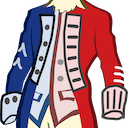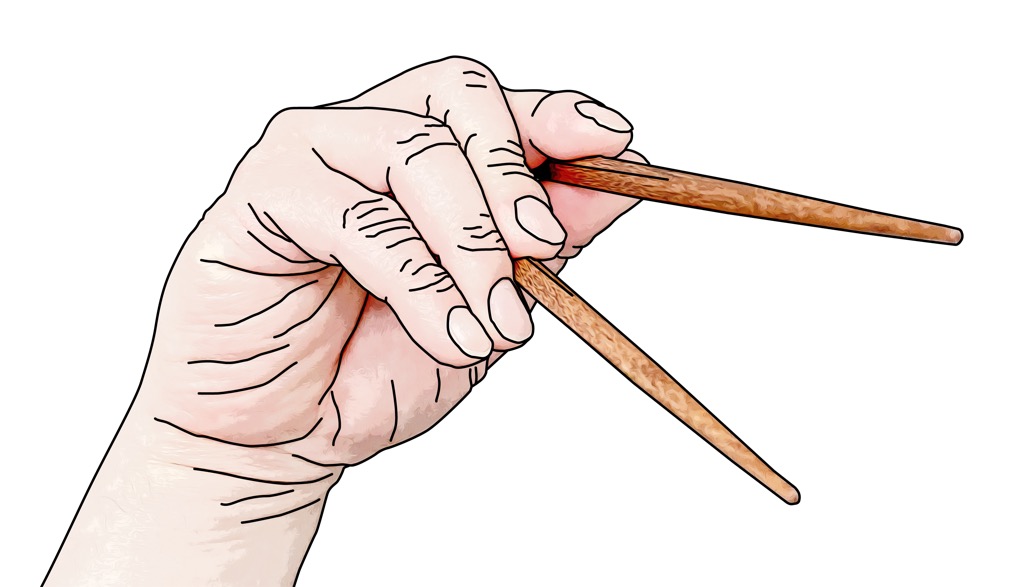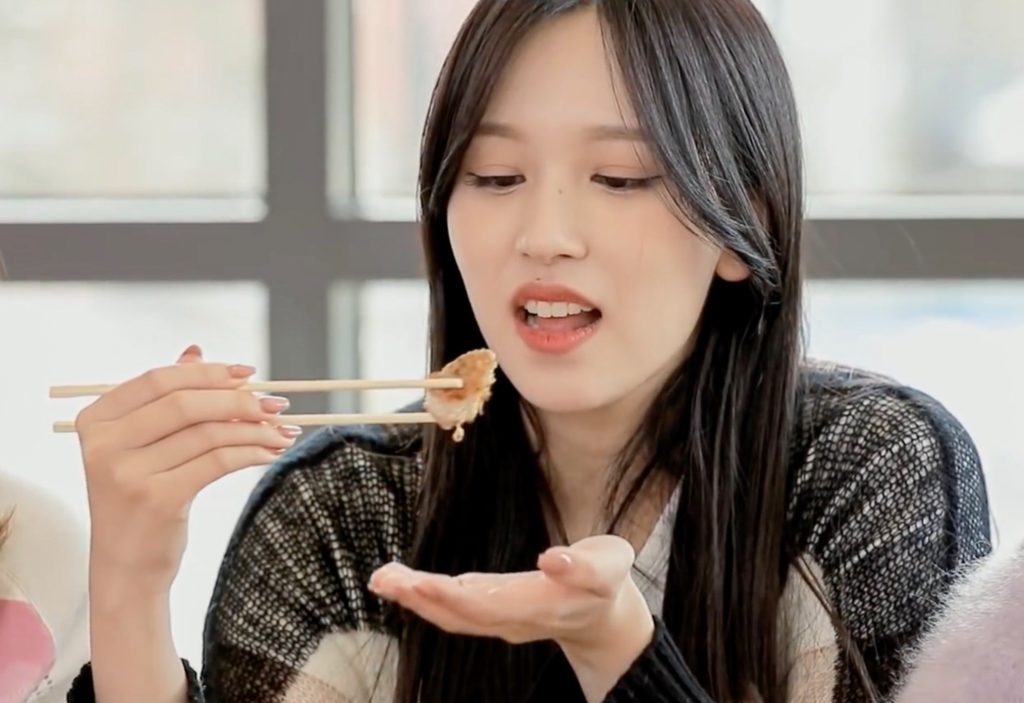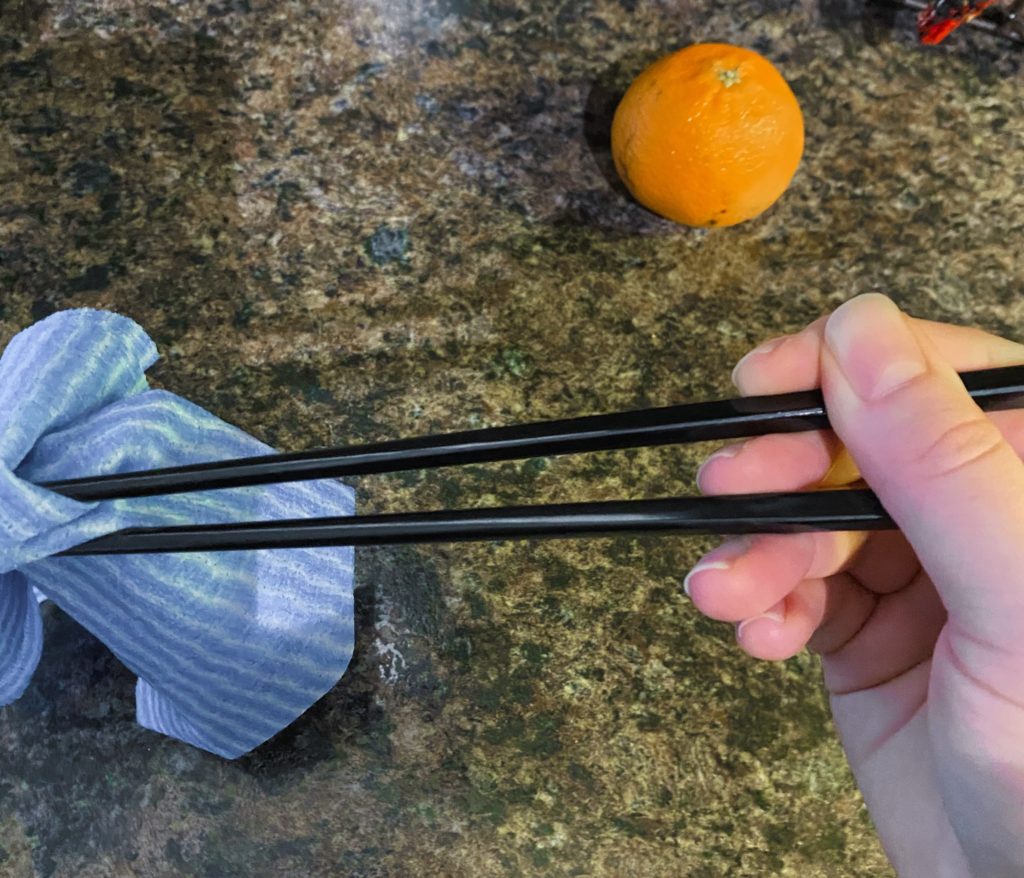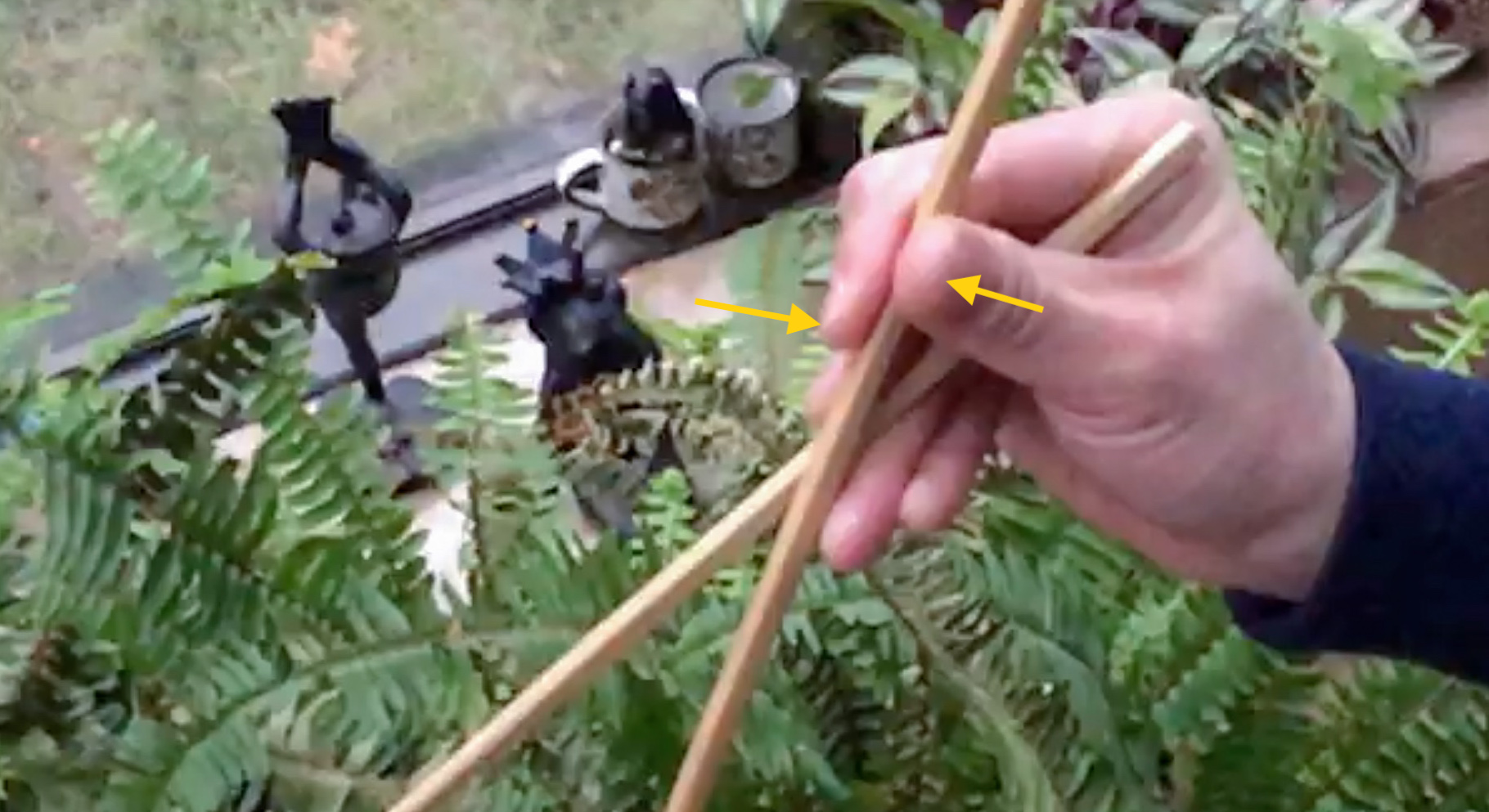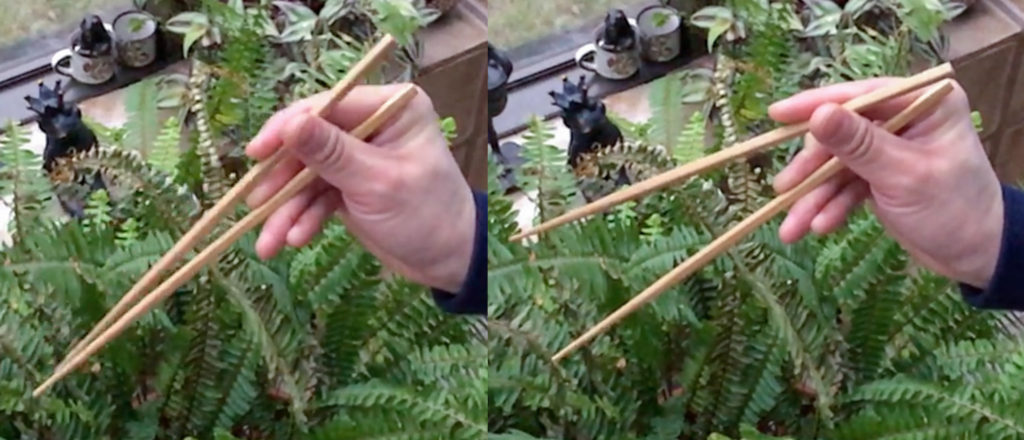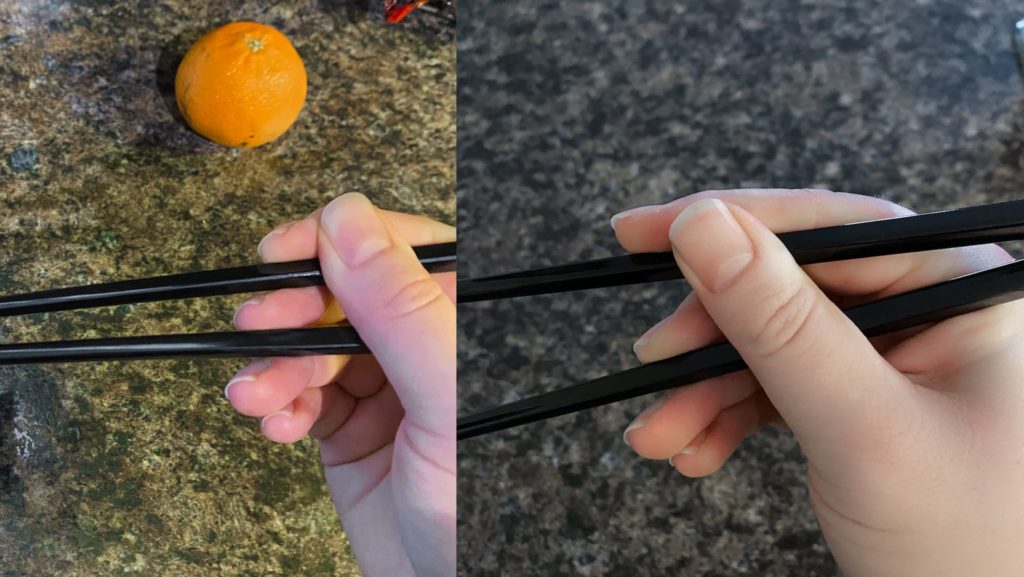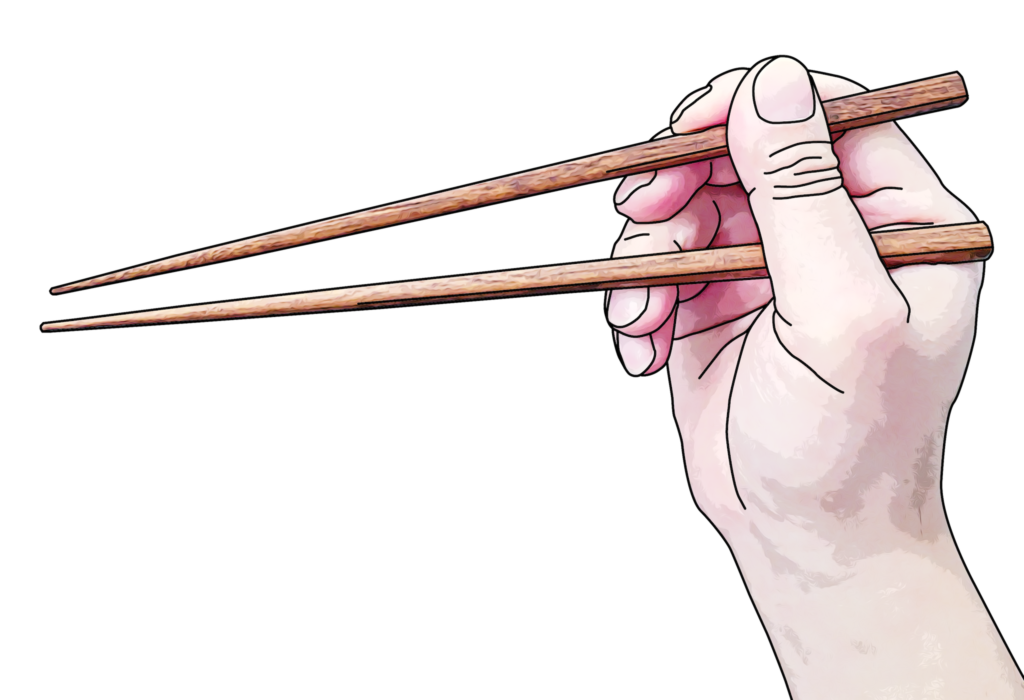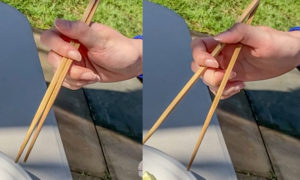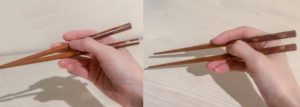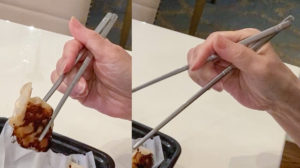Last Updated on August 22, 2021 by Staff
Turncoat Grip is the diametric opposite of the Forsaken Pinky grip. “Turncoat” refers to the middle finger, which defects from the gang of three. The turncoat deserts its post of manning the top chopstick with the tripod hold per Standard Grip. It then joins the ring finger and the pinky, to secure the bottom chopstick instead.
In contrast, Forsaken Pinky has the ring finger leave its post of supporting the bottom stick. The ring finger then joins the gang of three, to operate the top chopstick as a gang of four.
Turncoat Grip is nearly indistinguishable from the Flexible Middle variant section of Finger Pistol grip. They differ only in how the middle finger supports the bottom chopstick.
Following is the stereotypical open posture of Turncoat Grip, seen from various angles.

Table of Contents
Turncoat vs. Forsaken Pinky
We start by contrasting Turncoat (below left) to Forsaken Pinky (below right), with Standard Grip (center) as a mid-point reference. These pictures clearly illustrate why Turncoat is the diametric opposite of Forsaken Pinky.

The middle finger usually serves in the tripod hold of the top chopstick (above center). But it becomes a deserter in Turncoat Grip (left). The ring finger usually serves in the 1-on-2-support of the bottom chopstick (center). But it abandons the pinky in Forsaken Pinky grip (right).
These differences become less obvious at the closed posture. All pictures shown below look identical at a glance. But upon closer inspection, we note that both Turncoat (left) and Forsaken Grip (right) feature fingers that are extended (relatively) flat, compared to Standard Grip (center). This salient point will be expanded later, when we discuss the relationship between Turncoat and Finger Pistol.

Influence from instructions on wrappers
With the publication of this article, we complete our coverage of what we’ve come to call “unwise instructions on wrappers”. Previously we wrote about the undue influence of bad drawings on chopstick wrappers, in Vulcan Grip, Righthand Rule, and Finger Pistol. Now we discuss how some learners end up with the Turncoat grip because of these drawings.
A learner can be forgiven for believing that wrapper illustrations (left two) shown below are drawn using the Turncoat Grip user (right) as a model. Pay special attention to how these illustrations highlight the flattened pose of the four fingers: index, middle, ring and pinky.
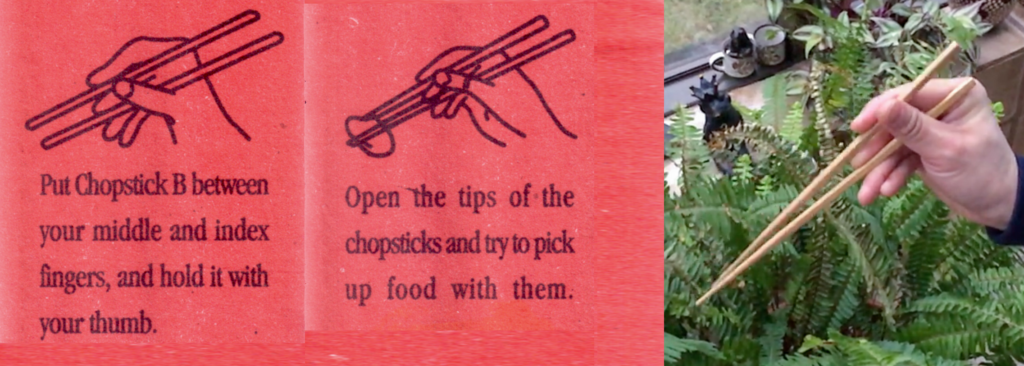
Following are more drawings from yet another chopstick wrapper. They also look indistinguishable from above drawings, and from the Turncoat Grip. When learners follow these drawings faithfully, they’ll invariably end up with the Turncoat grip.

Turncoat vs. Finger Pistol (Flexible Middle)
In the Flexible Middle variant section of Finger Pistol grip, we alluded to the inherent connection between that variant and Turncoat Grip. Both pictures shown below are taken with the same chopstick user. This user switches between Turncoat (below left) and Finger Pistol (below right), depending on what is needed at the time.

The difference between these two grips lie on how the middle finger is holding the bottom chopstick. In Turncoat (above left), the middle finger sits on top of the bottom chopstick. Because of its interjection in between the two sticks, rear ends of chopsticks are forced apart, at the closed posture, similar to how they are in Standard Grip.
In Finger Pistol (above right), the middle finger supports the bottom chopstick from the side. Since it does not come in between the two sticks, the index finger and the ring finger tend to squash the two chopsticks together. This causes their rear ends to be glued together throughout the alternating motion.
The degree of separation of rear ends at the closed posture has repercussions on how wide tips of chopsticks can be extended. Turncoat Grip (below left) can extend tips further apart than Finger Pistol (below right) can.
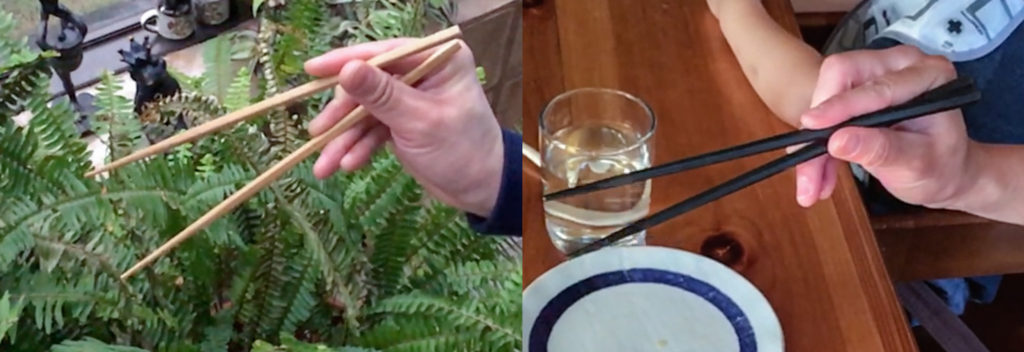
Transition from Finger Pistol
Following slow-motion video illustrates how a user switches from Finger Pistol to Turncoat Grip, in flight. As the middle finger moves into position and pries open the top chopstick, tips of chopsticks are extended further apart.
Following pictures illustrate how the two chopsticks are pried open (yellow line), as the middle finger moves from supporting the bottom chopstick from the side, to holding it from the top.

Transition to Finger Pistol
Similarly, the middle finger retracts from its Turncoat position, and supports the bottom chopstick from the side, as a user switches to the Finger Pistol grip.
An unstable grip
This grip is unstable. As discussed earlier, a user may switch into and out of this grip as needed. In addition, when the index finger pushes the top chopstick too much, past the closed posture, a user is often unable to recover from this overshooting action.
The following sequence illustrates a case where the top chopstick overshoots the closed posture.

In order to lift the top chopstick, something other than the index finger and the thumb is needed. Yellow arrows below indicate two points where forces may be applied by the index finger and the thumb. These forces are unable to pivot the top chopstick back to its open position.
Closing salad tongs
When closing salad tongs, in our typical strength test, the middle finger will retract to allow the hand to squash the two chopsticks together, in an attempt to generate enough compression force.
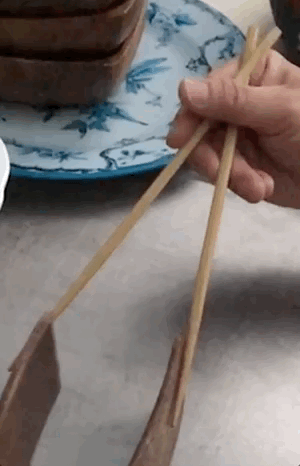
Opening salad tongs
When opening salad tongs, in our typical strength test, the middle will move into position to assist in prying the two chopsticks open.
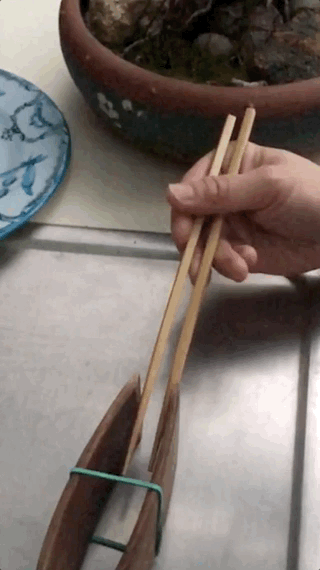
Used in combo with Standard Grip
Added 2021-05: In May 2021 we analyzed an excellent episode on chopsticks and chopsticking by World Friends YouTube channel. We published a writeup of this review in YouTube episode on chopsticking from WorldFriends.
All three hostesses wield more than one chopstick grips. Two of three hostesses naturally use Lateral compression. The hostess Kotoha, like this writer himself, believes that she only uses Standard Grip. But the reality is that Standard Grip and Turncoat share very similar Closed and Compression postures, when the rear ends of chopsticks are not separated far enough. Many practitioners, including Kotoha and this writer himself, subconsciously switch between these two grips, as situations call for.
In our studies of chopsticking, we find that carrying or not carrying a payload often alters how a practitioner wields chopsticks. A relaxed open posture is shown below left. A compression posture with noodles pinched between tips of chopsticks is shown below right. At a glance, these two images appear to illustrate the Standard Grip.

Following is a sequence of images showing Kotoha picking up noodles. They may still look like Standard Grip. But when one examines the middle finger more closely, one notices that this is indeed the Turncoat grip where the middle finger switches allegiance from the top chopstick to the bottom chopstick.
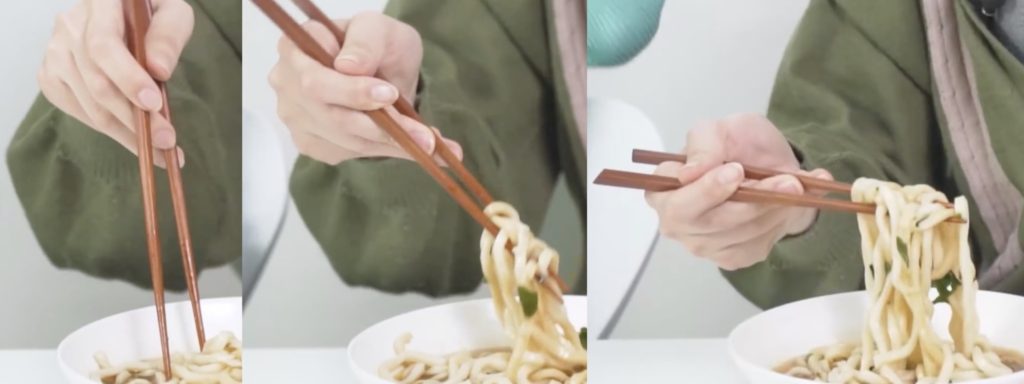
Following show the Closed posture and the Open posture, again without a payload. But this time they are shown from a more common perspective used on marcosticks.org. This allows us to compare them to other pictures from our Turncoat studies.
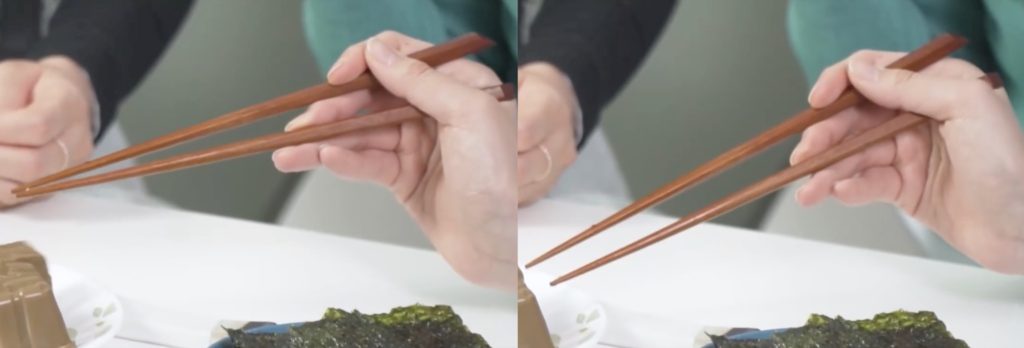
Look her pictures from above, to Turncoat pictures below.
Turncoat does look like Standard Grip. Most people can’t tell them apart at a glance. They are more differentiated at the Open posture. The image found below left shows the Max open posture of Standard Grip. The image below right shows the Open posture of Turncoat. The main difference between them is, of course, location of the middle finger.
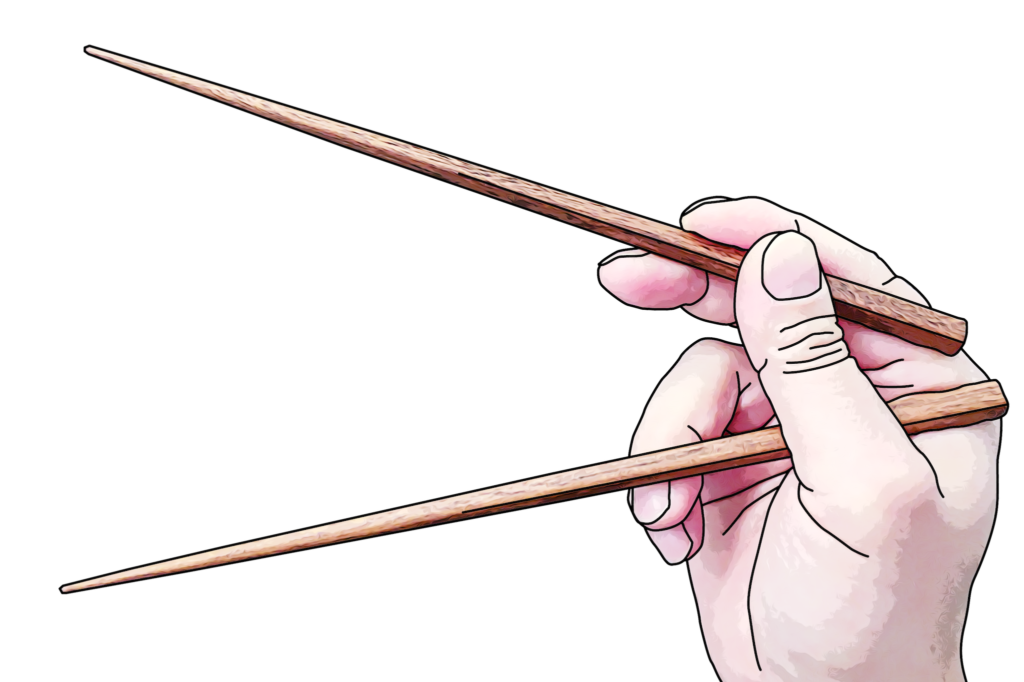
However, at the Closed posture, the boundary between these two grips is blurrier. The two pictures below look very similar. If the two chopsticks on the left (Standard Grip) were not separated far enough at the rear end, then the middle finger would touch both top chopstick and bottom chopstick, as is the case with Turncoat on the right.
We find more and more practitioners who alternate between Standard Grip and Turncoat. This writer himself only realized recently, that this fact applied to himself, too. Following images of Kotoha picking up jello more clearly show her Turncoat Compression posture in action.

Overlap between Idling Thumb and Turncoat
Added 2021-08-15: Many Idling Thumb practitioners also subconsciously shift the role of the middle finger from moving the top chopstick, to securing the bottom chopstick, when they compress these two chopsticks to pinch a food item. That is, they transition temporarily to Turncoat whenever needed, and transition out of it when they no longer need it.
Dahyun from our TWICE article provides a good example. Following are pictures of Dahyun momentarily assigning the middle finger the role of supporting the bottom chopstick. Note how her thumb pad does not assist the top chopstick, unlike in true Turncoat grip. Also note that while the pad of the middle finger is resting on the bottom chopstick, most of the time the top chopstick is also resting on the knuckle of the middle finger.

This pseudo and momentary Turncoat adoption is in fact necessary for many Idling Thumb practitioners, because when pinching relatively small food items, the gap between the two chopsticks is much reduced, where the middle finger meets chopsticks. This is not a problem for Standard Grip practitioners, because they utilize the thumb pad, and thus propping up the top chopstick far enough away from the bottom chopstick. In Idling Thumb, the joint of the thumb, and not the pad, holds the top chopstick in place, thus substantially lowering the top chopstick. This in turn requires that the middle finger be sandwiched between the top chopstick and the bottom chopstick.
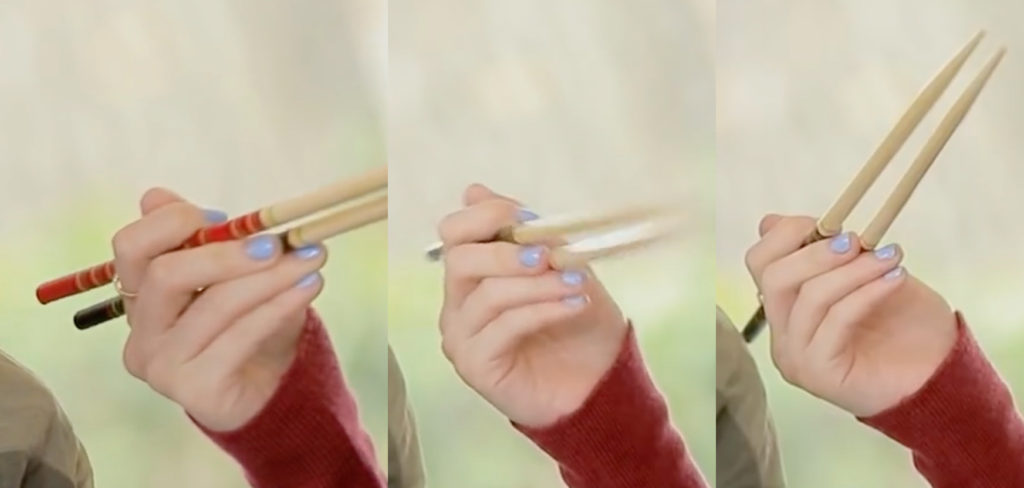
Mina’s Turncoat grip
Mina wield exclusively the Turncoat grip, unlike Dahyun who dabbles in Turncoat outside of her usual Idling Thumb routines.
Following images show typical hand and finger movements for picking up food, and for moving it to the mouth.




Learn new grips
Users of Turncoat Grip and its variants can add Standard grip to their chopsticking repertoire, by moving the middle finger up, to participate in the tripod hold on the top chopstick. Then the distal knuckles of the ring finger will naturally start to help with the 1-on-2-support for the bottom chopstick. Go on to Learn to Twirl Chopsticks if you are interested.
Taiwanese: 中指投誠
This grip is known as 中指投誠 (Tiong-cháiⁿ tâu-sêng) in Taiwanese. Both Mandarin and Taiwanese names paint the switching of allegiance of the middle finger in a positive light. There doesn’t appear to be such a term in English without negative connotations. Thus the unfortunate English name “turncoat”.

